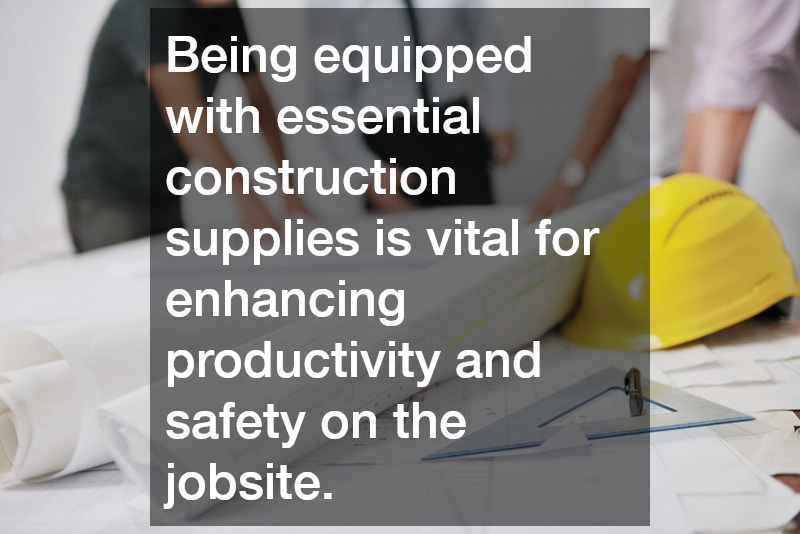Essential Construction Supplies Every Contractor Should Have
Having essential construction supplies readily available is crucial for contractors, as it directly impacts the efficiency and safety of their projects. The ability to complete tasks efficiently and safely often hinges on the accessibility and quality of the tools and materials at hand, influencing the overall success of construction work.
What are the Must-Have Basic Tools for Every Construction Site?
Hand Tools Necessary for Construction
Hand tools are the backbone of any construction site, with items like hammers, screwdrivers, and tape measures being indispensable for daily tasks. These tools are not only crucial for performing various tasks but also contribute significantly to the precision and quality of work on site.
A hammer is essential for framing tasks, driving nails, and performing demolition work, serving as a versatile tool in any contractor’s arsenal. Screwdrivers, available in multiple sizes and types, offer the flexibility needed to assemble or disassemble different components with ease.
Tape measures are instrumental in ensuring accurate measurements, which is vital for achieving precise project specifications. Inaccurate measurements can lead to costly errors, making reliable measuring tools a must-have for contractors to uphold quality craftsmanship.
Power Tools that Boost Productivity
Power tools such as drills, saws, and sanders drastically enhance productivity by enabling faster and more precise work. The advanced capabilities of these tools empower contractors to complete complex tasks with greater ease and less physical strain.
Drills, whether corded or cordless, are fundamental for creating holes and driving screws, offering versatility across various materials. Saws, including circular and reciprocating types, provide the cutting power necessary for handling different materials, from wood to metal.
Sanders ensure smooth finishes on surfaces, contributing to the quality of the completed work and reducing the need for extensive hand sanding. These power tools not only save time but also improve the overall safety of operations by minimizing manual exertion and potential errors.
Which Safety Supplies are Crucial for Protecting Workers?
Personal Protective Equipment (PPE)
Personal Protective Equipment (PPE) is essential for maintaining a safe working environment and preventing injuries on construction sites. This safety gear includes helmets, gloves, and goggles, each playing a specific role in safeguarding workers.
Helmets provide critical head protection from falling objects and impacts, reducing the risk of serious head injuries. Gloves, available in various materials, protect hands from sharp materials and harsh chemicals, while ensuring a firm grip on tools and equipment.
Goggles safeguard the eyes from dust, chemical splashes, and flying debris, maintaining the worker’s vision and preventing accidents. The proper use of PPE is crucial in ensuring compliance with safety regulations and fostering a culture of safety awareness among construction teams.
Safety Signage and Barriers
Safety signage and barriers play a pivotal role in upholding a secure construction site by directing and informing workers and visitors of potential hazards. Clear and visible signs ensure that everyone is aware of the rules and dangers associated with each area of the jobsite.
Barriers prevent unauthorized access to hazardous zones, minimizing the risk of accidents and injury by clearly delineating safe pathways. Consistent use of signage not only helps in complying with legal safety standards but also enhances communication among team members regarding site safety protocols.
Effective safety signage is critical, especially when machinery is in operation or when there are elevated risks, as it serves to remind workers to adhere to safety practices. Strategically placed signs and barriers can significantly reduce incidents, leading to more efficient project execution.
How Can Contractors Ensure Efficient Material Management?
Organizing and Storing Materials
Efficient organization and storage of materials are imperative for the smooth progress of construction projects. By implementing smart storage solutions, contractors can ensure quick access to necessary materials, saving both time and effort.
Protecting materials from environmental factors, such as moisture and extreme temperatures, prevents damage and waste. Proper storage includes the use of pallets, racks, and covered areas to keep supplies secure and well-ventilated.
Effective organization enhances inventory management, allowing contractors to track material usage and order supplies proactively. This strategic approach not only minimizes delays but also optimizes resource allocation and reduces cost overruns.
Strategic Purchasing and Inventory Management
Strategic purchasing decisions are vital for maintaining a balanced inventory, minimizing waste, and controlling expenses on construction projects. Establishing relationships with reliable suppliers ensures access to quality materials and timely deliveries.
Inventory management systems enable contractors to monitor stock levels, plan reordering, and track material usage accurately. These systems help in avoiding overstocking or stockouts, which can lead to financial losses and project delays.
Implementing just-in-time delivery methods allows for reduced on-site storage needs and capital investment in inventory. By refining purchasing strategies and inventory processes, contractors can enhance operational efficiency and achieve project goals more effectively.
In conclusion, being equipped with essential construction supplies is vital for enhancing productivity and safety on the jobsite. Key tools, safety supplies, and efficient material management practices significantly contribute to the success of construction projects.
Contractors should prioritize regular assessment and updates of their supply inventory to meet evolving project demands. By investing in the right tools and supplies, contractors can ensure their teams are prepared to tackle any challenge, leading to improved project outcomes and client satisfaction.

